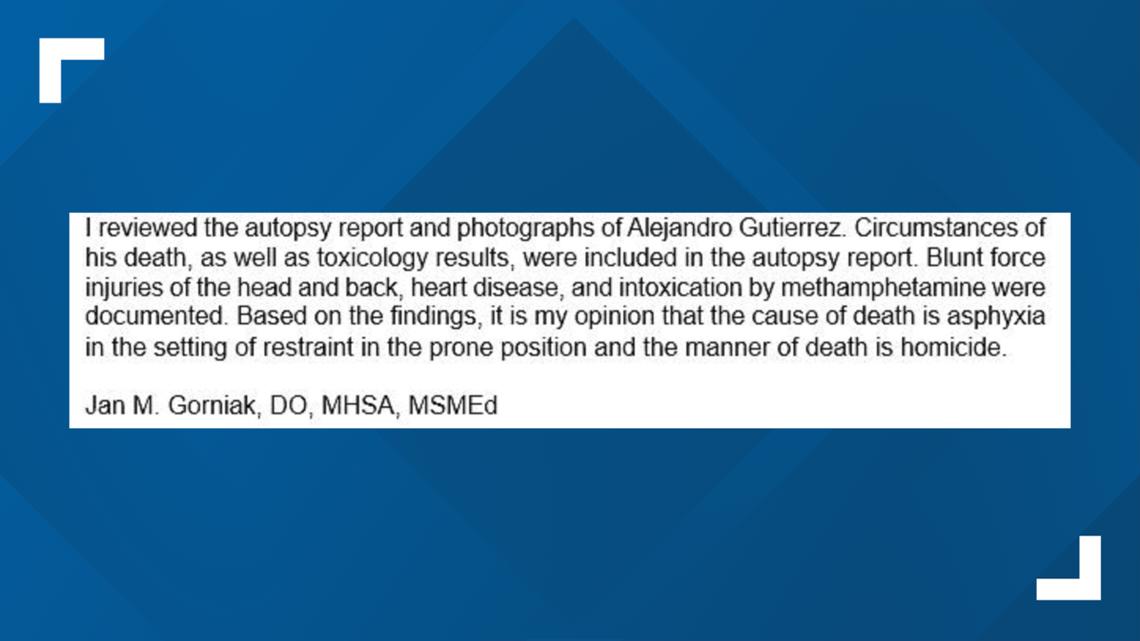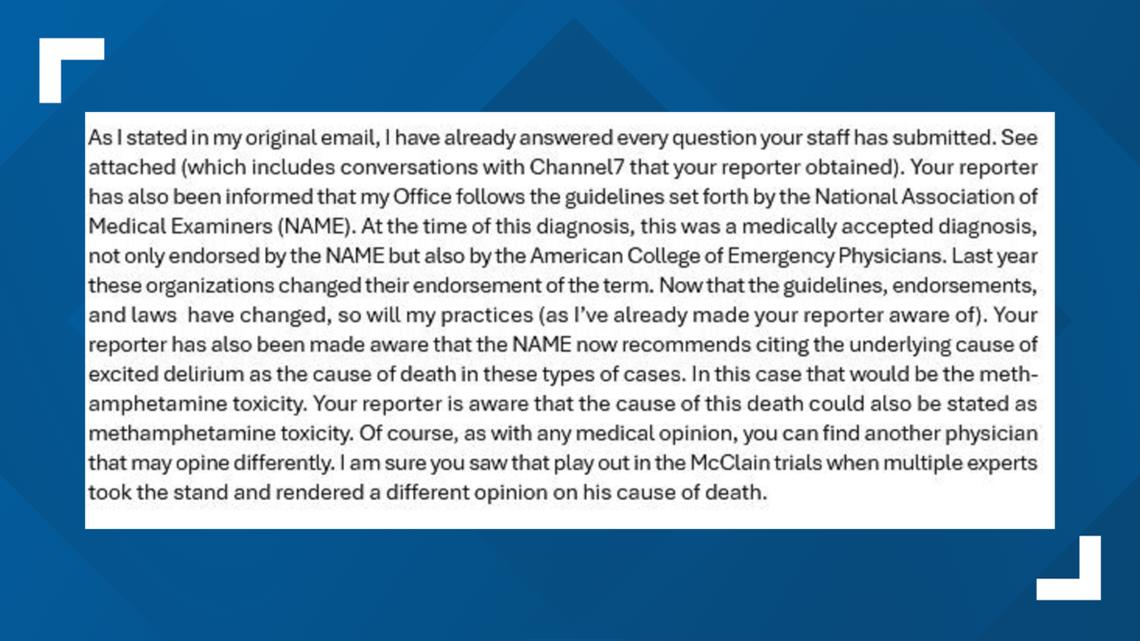ADAMS COUNTY, Colo. — Seven years after a facedown man suddenly died under the knees, arms and bodies of arresting officers in Adams County, two board-certified forensic pathologists tell 9NEWS Investigates the elected Adams County coroner was wrong when she concluded the man’s death had nothing to do with the officers’ actions.
The death of Alex Gutierrez in 2017 generated little more than a few mentions in the local Colorado press. When the Adams County Coroner blamed his death on something known as “excited delirium” a few months later, the case effectively disappeared. It seemed simple. Man trying to sell drugs was chased by cops, a fight ensued, and the man died.
When the local district attorney reviewed the case, he cited the term “excited delirium” when he cleared all officers involved in the restraint. End of story. Or so it might have seemed.


I only came across the case in 2022 while examining deaths across the state that followed law enforcement restraint.
At the time, I was investigating use of the term “excited delirium” in several of the deaths.
Even then, you didn’t need to do many Google searches to understand the significance. For decades, coroners and law enforcement officers had cited the controversial term as a reason why someone died during or shortly after law enforcement restraint. Think of it like a theory built on an idea that a body can become so excited and the mind so delirious that the heart just stops.
Critics called it an excuse for bad, if not potentially criminal, behavior. Why, for example, did it only seem to cause the deaths of people being restrained?
Even a brief examination of the Gutierrez case told me “excited delirium” didn’t exactly seem to fit. At least twice Gutierrez yelled “I can’t breathe” to a Thornton Police officer on top of him trying to place handcuffs. That’s hardly the exclamation of someone undergoing delirium.
He was sweaty, sure, and had what officers noted was remarkable strength.
But those are also symptoms of someone who, for example, can’t breathe and thinks he might be about to die.
Then there is a video recorded on a Federal Heights Police officer’s body camera. It clearly shows Gutierrez facedown, with handcuffs on, with an officer’s knee on his back.
I’ve covered so-called prone restraint deaths for years, and that meant I was well aware of the fact that as far back as 1995 the U.S. Department of Justice started warning officers not to linger on the backs of handcuffed individuals due to risk of “sudden death.”
In late 2022, I met Gutierrez’s daughter. At the time, Avina De Luna seemed, at the very least, remarkably uncomfortable with the “excited delirium” determination.


She too had Googled the term.
Not that it mattered much to the Adams County Coroner’s office. Repeatedly, the elected coroner Monica Broncucia-Jordan rebuffed De Luna’s requests to meet. Yes, the “excited delirium” determination had increasingly fallen out of favor since the Gutierrez death, but there was no indication Broncucia-Jordan had any intention of changing her mind on the Gutierrez case.
“I was told to stop emailing them. They’re not going to respond,” De Luna told us.
And so, in 2024, 9NEWS asked a pair of forensic pathologists to do the job Broncucia-Jordan refused to do.
A few months ago, we brought you the story of Dr. Jan Gorniak’s review of the autopsy file.
“I have no doubt this case is a homicide,” she told us. “None.”


Just in case you’re curious, we should mention that a “homicide” determination by a forensic pathologist is quite a bit different than the same determination from a prosecutor, for example.
Forensic pathologists don’t determine criminal responsibility. In their minds, a homicide is simply a death that happens at the hands of another. Homicides, for example, can be justified. Think of a man shooting at police officers who is killed during return fire.
To put it bluntly, Gorniak wasn’t saying she believed the officers were criminally responsible for the death. She said she simply believes the officers’ actions that night were responsible for it.


“But for the restraint, Mr. Gutierrez would not have died,” Gorniak told us.
I met Dr. Victor Weedn for the first time when he came to Denver to take part in the annual conference of the National Association of Medical Examiners in September. NAME, as it’s called, is well respected in the study of death. Even Broncucia-Jordan personally told us in an email it is “the leading association in forensic medicine and pathology” in the country.
At the time, both Weedn and Gorniak were NAME board members. Both made a point to say they do not speak on behalf of NAME for the purposes of this story.
In Denver, Weedn told me his review of the Gutierrez autopsy file, provided by the Adams County Coroner, told him Gutierrez’s death was the direct result of the restraint.
“Is this a homicide?” I asked him.
“Yes,” he replied. “The death would not have occurred but for the actions of police.”
“Did the Adams County Coroner’s Office get this conclusion wrong?”
“Yes,” he said. “I believe for sure they got it wrong.”


To bolster his argument, he cited the emergency medical services report 9NEWS obtained.
That report highlighted the presence of something known as “pulseless electrical activity,” or PEA.
Weedn told us that amounts to what might as well be the proverbial smoking gun.
“When I saw that, I knew immediately that this is another case of prone restraint cardiac arrest,” he said.
His research suggests PEA can be the net result of something known as metabolic acidosis.
“When somebody is exerting themselves physically, they can build up a lot of lactic acid. They typically compensate for that lactic acid buildup – that acidosis – by breathing really fast,” he said.
“In practical terms, we physicians say we blow off [carbon dioxide] and that’s the treatment,” he said.
The problem can become fatal, he said, if someone is in a position that doesn’t accommodate effective respiratory input and output.
Like, for example, someone being held in a prone – facedown – position with a knee on their back.
“People don’t appreciate how quickly this can happen,” he said.
The presence of PEA, according to Weedn, also told him that the Gutierrez death was not the result of the meth in his system, as has been suggested by Broncucia-Jordan in previous correspondences with 9NEWS and other media outlets.


“It’s not the stimulant drug. It’s not excited delirium. Here is a very good explanation that is well documented,” Weedn said.
“The coroner had this emergency services report. I just don’t think they recognized what it told them,” he said.
While a 9NEWS review of the Gutierrez death has uncovered a number of inconsistencies, few may be more consequential than the issue of whether or not Gutierrez was prone with a knee on his back when he went unresponsive.
In an email sent to a reporter at KMGH-TV in May and obtained by 9NEWS during an open records request, Broncucia-Jordan told the reporter, “Witness reports also do not place this individual prone when he went unresponsive.”
It’s a claim that is disproven by two critical pieces of evidence.
First, the body camera video shows Gutierrez prone and lifeless.
Second, the Adams County District Attorney conceded during his investigation that “at no point during the recording does Mr. Gutierrez appear to make any voluntary movement.”
In addition, during subsequent interviews with the arresting officers, one officer appears to have, at the very least, misstated the facts of the case.
“Definitely no knee in the back or neck,” said the Thornton officer. “Obviously we’ve been through enough training and done enough things where that’s not the best position for uh, an officer or a suspect to be in,” he said.
It’s why we have repeatedly sought to ask Broncucia-Jordan and the medical examiner employed by her office if they ever watched the body camera video of the restraint.
She has repeatedly refused to meet with us and answer questions we have. On two occasions, we tried to interview her at her office. Both times she walked (or drove) away from our camera.
She did send an email to the general manager of 9NEWS calling me “incompetent” and my “use of the deceased, for his own aggrandizement, disgusting.”
“I have no desire to interview with him,” she stated.
Of course, if she reads this and decides the work of Drs. Gorniak and Weedn is potentially sufficient enough to ask for another review of this case, I would welcome a response at chris.vanderveen@9news.com.

